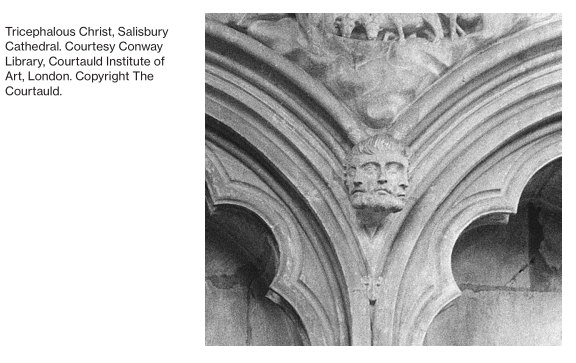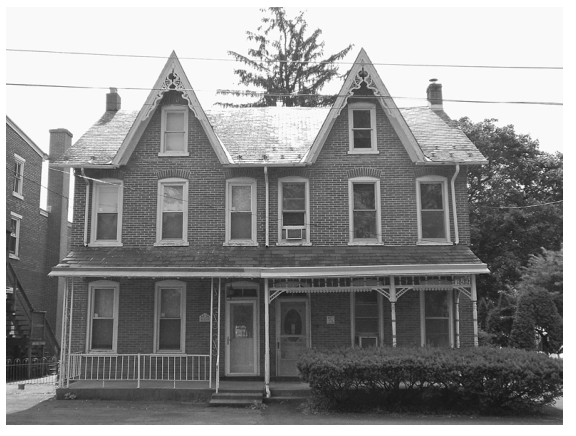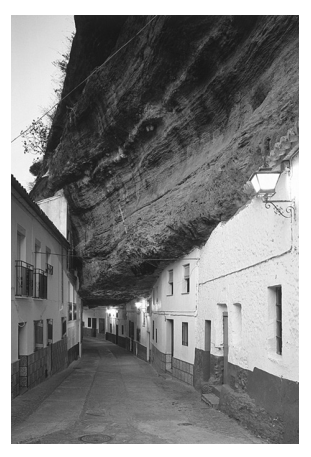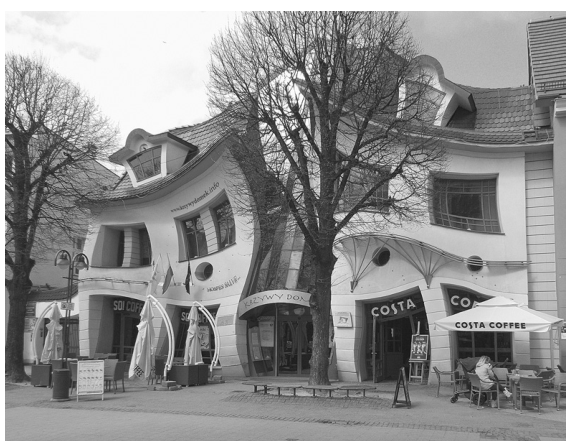created, $=dv.current().file.ctime & modified, =this.modified
tags:architectureartmonsters
NOTE
Re-read of the new edition
The central argument in HiA was that “unprecendented” moments - and transitional ones - create monsters. This new edition sharpens how interesting times makes interesting buildings.
sublime
a mode of feeling that bypassed the eye, skirted rationality, and addressed our inner nature. The terrible was one form of sublimity, alongside the noble and the splendid.
Burnet praised: ‘natural vistas that were ill-figur’d” and “confused”’
Tricephalous Christ

Horror is an ever-present and radically protean effect. It exists whenever the established language of a building is overtaken by requirements of other organizations, scales, technologies and activities. It is a chronic symptom of modernity’s violent and cyclical dynamism, its expansions and convulsions and metamorphoses. For this reason, unease remains endemic in the build environment.
Doubles and Clones
Opposition is true Friendship - William Blake
In doubles and clones, the overpowering cultural logic of mass manufacture conflicts with lingering transcultural concerns about human uniqueness
conflict with subsumption of individuality with a mass character.
- The Nose - Major Kovalyov discovers his nose has left his face and has appropriated his roles in bureaucracy and society.
- The Double - Protag can recognize his own ego in an alien body as it follows him along a darkened street.
The horror stems not from inauthentic replication, but from authenticity which calls into question the legitimacy of the original.
World Trade Center (1973) differed from other doubles in that each skyscraper gave the impression of being symmetrical and autonomous unto itself, neither unbalanced nor lacking any element that would expect a mirroring double.
A semi-detached house

NOTE
[Roses between yards] concept
That “the Englishman’s home is his castle” implies both discreteness and defense.
On Semi’s
And certainly, anyone who has lived in one can attest to problems with unclear boundaries, incomplete acoustic separation, and incidental and unwanted visual access.
The architect’s courtship of mass manufacturing reached an apex in a range of modularity movements of the 1960s and 1970s, in prefabrication, and in Japa- nese Metabolism. In these, the fully assembled dwelling— be it a room, an apart- ment, or a freestanding house— was to be delivered directly from factory to site.
Exquisite Corpse
surrealism Parlor game by Breton and the Parisian Surrealists. Participants passed a folded sheet of paper each contributing a drawing, word or phrase without knowing what had come before. When the paper was opened it displayed surprising combinations, fractured figures and phrases that gleefully subverted norms of painterly or literary coherence.
Shelley’s golem was a prescient image of destabilizing technological modernity, a century before fragmented paintings came to represent dislocation and schizo- phrenia.
This follows more in the premodern traditions of Hieronymus Bosch and François Rabelais, who pioneered the polymorphism of obscene and bestial com- binations in the medium of the carnivalesque. These built on folk traditions of wild excess, as described by M. M. Bakhtin. 6 Such transgressions included the hybridizing and exchange of human and canine or bovine anatomies, honorifics and responsibilities given (fleetingly) to pigs and dogs, and identification of reli- gious figures with animal avatars. 7 In carnival, the person is not a singularity but a collective— a disgusting little society, one in which biophysical tropes are awk- wardly or inimically related. This “social body” suggests an uneasy community
In his influential essay “Bigness,” Koolhaas transposed the thematic of the Manhattan tower onto the horizontal axis. He argued that unprecedented scales were pushing new construction into a realm of incoherence, in which conventional methods were no longer reliable. The straining Rabelaisian bodies of malls, expo centers, and mixed- use megaliths were increasingly characterized by inchoate interiors that obeyed neither classical hierarchies nor modernist grids.
Partially and Mostly Dead
Vladimir Nabokov
I looked at houses and they had lost their usual meaning.. leaving nothing but an absurd shell… I understood the horror of a human face. Anatomy, sexual distinctions, the notion of “legs” “arms” “clothes” - all that was abolished, there remained in front of me a mere something not even a creature, for that is too human a concept, but merely a something moving past.
Dead malls: A slow decline commonly marks the death of this typology, in which sur- viving units abut empty ones
Bangkok the owners of the New World Shopping Center flooded the complex’s ground floor for tilapia and catfish farming

Poe: “imbibed of the shadows of fallen columns”.
Reiteration and Reflexivity
The building made from algorithms, generative buildings, L-systems
Reiteration has perhaps its clearest analogue in the botanical realm. Horticulturists have long used this term to describe how a plant, under conditions of exceptional environmental stress— gales, lightning strikes, or uncontrolled browsing by animals— will grow itself anew. It attempts to survive via replication, and to use its own tissue as a substrate. A tree suffering root compression, for example, produces “water shoots”: stems that emerge with a signature that contrasts normal branching. These are rigidly vertical and look very much like saplings. That is precisely what they are. The individual is attempting to regrow itself, away from perceived danger.
Incontinent Objects
Speech, consumption and excretion are acts that connect the social world to the otherwise inscrutable interior.
Holes The desired predictability of the orifice is merged, in horror, with the illogic of the hole. The latter is an unexpected perforation of the body’s external mem- brane. Holes are disturbing by degrees: cuts and wounds are unwelcome; gaping voids are worse. But acutely horrific is the appearance of a functionally specific aperture where it is not supposed to be.
Concealment of the negatives
Modern buildings, like modern subjects, thus became invested with a secretive internal hinterland. Channeled winds, mobile waste, captive lightning— these are now encased behind the surfaces of the home and the office. Those familiar with construction have seen these recesses, and know how their contents stand in obscene and dangerous contrast to bourgeois architecture and its order of self-representation. The unspeakable “truth” of the respectable façade or interior is that which is concealed in these cavities. To sustain this disappearing act, the wall is today conceived as a complex assembly of membranes organized around a central vacancy. Again, this is quite recent. The body of the antique building had no unseemly inside; its poché Words was merely a structural mass that emulated the solidity of stone or earth.
Solidity
Solidity is a truly horrible phenomenon, an irreconcilable, existential terror. The solid provides no space, either physically or philosophically for inhabitation. The geological is the antithesis of the human. Impenetrability, the thingly resistance to appropriation, discomfits. Rock is mute, indelible — the absolute opposite of consciousness and social life.
[Caves] and mountain hollows have long been cast as the homes of the nonhuman: dragons, trolls, dwarfs and their ilk.

Distortion

The anamorphic projection, while it causes an object or volume to appear misshapen at almost any vantage point, resolves to a normal appearance when viewed from a privileged location.

Puppets
[Puppets]
Puppetry presents a physical extremity as a body, as a living thing, whole unto itself. It projects the illusion of an independent sentience on what is merely an appendage: the contiguity of a broader, unknown, and possibly malevolent intelligence.